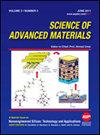Effects of Tolerant Nanoparticles Loaded with Various Regulatory Molecules on the Development of Experimental Autoimmune Encephalomyelitis
IF 0.9
4区 材料科学
引用次数: 0
Abstract
This research investigated the effects of tolerating nanoparticles (tNPs) loaded with multiple regulatory molecules on progression of experimental autoimmune encephalomyelitis (EAE). The polylactic acid-glycolic acid copolymer (PLGA), multiple regulatory molecular fragments (Fc) (programmed death receptor ligand 1-Fc (PD-L1-Fc), CD47-Fc), transforming growth factor (TGF-β1), and multiple oligodendrocyte glycoprotein (MOG) antigen peptides (p-MOG) were selected to prepare the tNPs (MRM-tNPs) loaded with various regulatory molecules. Then, the MRM-tNPs were applied in MOG35-55 polypeptide-induced EAE mouse model. According to the treatment methods, the mice were rolled into a group A (BS therapeutic agent), a group B (no-load-NPs), a group C (MOG-tNPs), and a group D (MRM-tNPs). The therapeutic effects were evaluated by the inflammatory infiltration degree (IID), demyelination loss degree (DLD), and apoptosis rate (AR) of CD4+ and CD8+ T cells. The Results showed that the encapsulation rate (ER) of TGF-β1 was 87.65%, and its cumulative release rate (RR) was 58.22%. There were obvious fluorescence signals on MRM-tNPs, MRM-tNPs without PD-L1, and MRM-tNPs without CD47. The neurological function (NF) score in the group D after MRM-tNPs treatment was less than 2 points (P <0.05). The scores of IID and DLD in the brain and spinal cord (SC) of EAE mice in the group D were much lower to those in groups A, B, and C, and the ARs of CD4+ and CD8+ T cells were higher (P <0.05). In conclusion, the tNPs loaded with various regulatory molecules can promote the apoptosis of antigen-specific T cells (AST) and reduce the infiltration and demyelination of inflammatory cells, thus alleviating the EAE.负载多种调节分子的耐受性纳米粒子对实验性自身免疫性脑脊髓炎发展的影响
本研究探讨了负载多种调控分子的耐受性纳米颗粒(tNPs)对实验性自身免疫性脑脊髓炎(EAE)进展的影响。选择聚乳酸-乙醇酸共聚物(PLGA)、多调控分子片段(Fc)(程序性死亡受体配体1-Fc (PD-L1-Fc)、CD47-Fc)、转化生长因子(TGF-β1)、多少突胶质细胞糖蛋白(MOG)抗原肽(p-MOG),制备装载多种调控分子的tNPs (MRM-tNPs)。然后,将MRM-tNPs应用于MOG35-55多肽诱导的EAE小鼠模型。按治疗方法将小鼠分为a组(BS治疗剂)、B组(空载nps)、C组(MOG-tNPs)和D组(MRM-tNPs)。通过观察CD4+和CD8+ T细胞的炎症浸润度(IID)、脱髓鞘丢失度(DLD)和凋亡率(AR)来评价治疗效果。结果表明,TGF-β1包封率(ER)为87.65%,累积释放率(RR)为58.22%。MRM-tNPs、不含PD-L1的MRM-tNPs和不含CD47的MRM-tNPs均有明显的荧光信号。D组经MRM-tNPs治疗后神经功能评分均小于2分(P <0.05)。D组EAE小鼠脑脊髓(SC) IID和DLD评分明显低于A、B、C组,CD4+和CD8+ T细胞ARs明显高于A、B、C组(P <0.05)。综上所述,负载多种调控分子的tNPs可以促进抗原特异性T细胞(AST)的凋亡,减少炎症细胞的浸润和脱髓鞘,从而减轻EAE。
本文章由计算机程序翻译,如有差异,请以英文原文为准。
求助全文
约1分钟内获得全文
求助全文
来源期刊

Science of Advanced Materials
NANOSCIENCE & NANOTECHNOLOGY-MATERIALS SCIENCE, MULTIDISCIPLINARY
自引率
11.10%
发文量
98
审稿时长
4.4 months
 求助内容:
求助内容: 应助结果提醒方式:
应助结果提醒方式:


